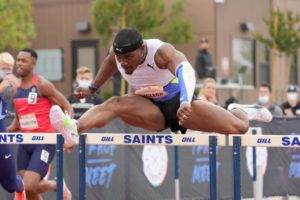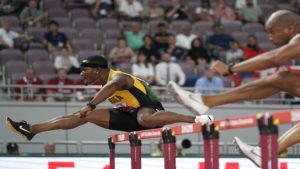How Omar McLeod Can Serve as a Model For Smaller Hurdlers
by Steve McGill
In last month’s issue of The Hurdle Magazine, I wrote an article comparing the hurdling styles of Grant Holloway and Orlando Ortega. Since I wrote that article, Jamaica’s Omar McLeod has run a couple of electrifying races, including a world-leading 13.01 in Italy last week, prompting me to think to myself, dang, how’d I forget about Omar? But the truth is I didn’t forget about Omar. As a smaller hurdler, he kind of falls into his own category when it comes to analyzing his technique. McLeod has had his share of the highest highs and the lowest lows in his career thus far, as he has been an Olympic champion but he has also had some bad crashes and ugly spills. But the 13.01 he ran in Italy last week serves as a prime example of why McLeod, when he is at the top of his game, can be considered an outstanding technician and the quintessential role model for smaller hurdlers trying to figure out how to adapt to the height of the barriers. In this article, I will discuss his strengths and weaknesses while explaining how smaller hurdlers sometimes must break the rules when it comes to what is “correct” vs. what is “incorrect” when it comes to clearing the obstacles.
[am4show not_have=’g5;’]
[/am4show][am4guest]
[/am4guest][am4show have=’g5;’]
Firstly, let’s discuss how the rules don’t necessarily apply to smaller hurdlers like McLeod, who is 5-10. For such hurdlers, the margin for error when it comes to technical mistakes is minimal in comparison to average-sized hurdlers and taller hurdlers. For example, while all hurdlers should lean forward from the waist when attacking the hurdle, taller hurdlers can get away with not leaning without suffering any significant consequences, whereas smaller hurdlers are more likely to make contact with the crossbar. The lack of a lean can also lead to floating issues, balance issues, and difficulty maintaining speed between the hurdles. Then there’s the question as to when the lead leg should begin to cycle back down to the track during hurdle clearance. Normally, I tell my hurdlers that they should begin to descend as soon as the heel of the lead leg foot crosses the bar. But with smaller hurdlers, beginning to descend that soon will lead to the hamstring of the leg making contact with the hurdle on the way down. So smaller hurdlers have to wait a little longer—until the underside of the knee has crossed the bar, before they can begin to descend off the hurdle.
With McLeod, what impressed me so much with his 13.01 last week was that he didn’t even touch one hurdle. He was aggressive the whole race, but not only did he run a clean race, but he had great balance the whole time, and his race was actually quite fluid. The photo below is from a race earlier this month, where McLeod ran 13.04. Let’s take a look.

What stands out to me here is how deeply he is leaning. When McLeod gets into trouble and starts smacking hurdles and veering into other people’s lanes, you can be sure that he’s probably hurdling too upright. And the angle of the lean here is lovely. He’s keeping his eyes up, his chin up, and he’s leaning forward from the waist. Why does that matter? Why is that so essential? One of the reasons has to do with the trail leg. For any hurdler, the deeper the lean is from the waist, the higher the trail leg raises. So again, for the smaller hurdler, the deep lean is essential in order to avoid the trail leg being too low and hitting the crossbar. As the photo shows, the margin for error is very narrow. If he were to lean any less than he is leaning here, the trail leg will be too low and it will hit the hurdle as it drives to the front. As it is, the trail leg will rise just enough that contact will be avoided, but he won’t be forced to raise his hips to avoid the contact. This is an ideal situation because it means there will be no interruption of the rhythm.
Another mistake that McLeod is prone to make is that of locking the knee of the lead leg. Locking the knee will cause the leg to pause, which causes the trail leg to pause as well, which causes a twisting of the hips. The lead leg as we see it in the photo is perfect. Slightly bent at the knee, ready to cycle down so that the heel will land under the hip. This position will allow for a seamless transition back to sprinting off the hurdle.
What the photo also shows us is how flexible and strong smaller hurdlers need to be. He is basically laid out flat over the hurdle. When I coached Wayne Davis back in the day, who was also 5-10, he was able to put his body in such positions as well. When he went to college and the hurdles were three inches higher, he had to learn how to do it all over again. The style of hurdling that I teach, which I refer to as downhill hurdling, is something that smaller hurdlers can’t really do. They would have to raise the hips too much. But smaller hurdlers can still apply the same principles—a forceful push off the back leg, a deep lean from the waist, driving the trail leg to the front as soon as it pushes off, and cycling both legs back to the ground, one behind the other. But hurdle clearance as a whole will need to be more horizontal than for taller hurdlers.
Let’s take a look at one more photo, this one from a couple years ago:

In this photo, you can see that his lead leg remains horizontal very late in hurdle clearance. Normally I would say, What are you doing? Attack the track! But as I said before, he’s doing what he must do as a smaller hurdler. Were he to begin his descent too soon, or were he to come out of his lean too soon (both go hand in hand, actually), he would be sure to make contact with the hurdle and a ripple effect of bad things would happen. So I’m really liking what I’m seeing in this photo.
While it would be easy to label McLeod a poor technician based on that time he ran into Shubenkov and that time he ran into Ortega, such a labeling would be a gross oversimplification, and evidence that you are looking at his style from the perspective of a “casual,” as the young people say. McLeod is actually a very good technician who, as a smaller hurdler, must deal with a much smaller margin for error when it comes to the price to be paid for technical errors. As a coach, I would definitely advise my smaller hurdlers to study McLeod’s races on YouTube. Watching him will help them to understand the challenges that smaller hurdlers face, and how to deal with them. Yes, it does help that McLeod has world class sprinter speed, but the things he does in terms of body positioning are equally important to his success. Below is the video of his world-leading 13.01 from last week.
[/am4show]
